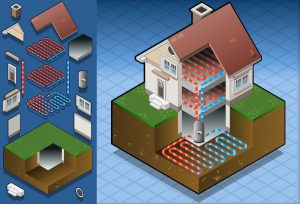 As homeowners look to cut expenses and explore alternatives to electric or gas heating and cooling, too many times geothermal energy is overlooked. That’s too bad, because there are plenty of reasons why it’s a good source of energy for heating and cooling applications. Below, we’ll discuss why geothermal heating and cooling may be the perfect answer to your needs – and why. If you’re looking to keep your home at the perfect temperature, while keeping the planet green, this is your answer.
As homeowners look to cut expenses and explore alternatives to electric or gas heating and cooling, too many times geothermal energy is overlooked. That’s too bad, because there are plenty of reasons why it’s a good source of energy for heating and cooling applications. Below, we’ll discuss why geothermal heating and cooling may be the perfect answer to your needs – and why. If you’re looking to keep your home at the perfect temperature, while keeping the planet green, this is your answer.
Why Go with Geothermal Heating and Cooling?
Let’s take a look at some of the many benefits of geothermal energy:
- Reliability: Since geothermal energy is something that’s produced within the earth constantly, it’s a reliable and consistent source for renewable energy, 24 hours a day (unlike wind or solar power).
- Zero Carbon Footprint: Geothermal energy doesn’t require combustion, unlike fossil fuels. As a result, there’s almost no greenhouse gases, and many geothermal power plants are capable of operating with literally zero emissions.
- Local: Whether it’s by transmission lines and substations, pipeline, railroad or truck, fossil fuels and other traditional types of energy need to be distributed or shipped through a region to power homes. Geothermal energy is located wherever there is a need and requires no distribution network and infrastructure.
- Low Cost: This renewable resource may cost more on the front end as an initial investment, but studies show that geothermal energy can save as much as 80 percent on energy bills as compared to fossil fuels.
- Accessibility: Coal has to be mined, oil has to be surveyed, explored and drilled – but geothermal energy is available in practically any location on the planet. While the technology for geothermal energy harvesting is still emerging, it’s still a lot less invasive and environmentally damaging than fossil fuel access.
Geothermal Heat Pumps for Transferring Heat
Let’s talk about the geothermal heat pump for a moment.
These units use loops of piping filled with liquid or glycol, which are then connected to your home’s heat pump. In the colder months, the liquid taps into underground heat and delivers it to your heat pump, with a forced-air system to heat your home.
In the summer, the heat pump removes heat from the home and transfers it underground.
This type of system is expensive to install – but remember that it isn’t burning any energy at all, ever.
Instead, a geothermal heat pump is transferring and moving heat from one place to another. Temperatures deep underground remain at about 50 degrees year-round, making its job in the summer months much easier.
Keeping that in mind, the up-front cost of a geothermal heat pump could be recouped in 4 to 15 years for most applications.
You can figure on a savings of 30 to 60% for heating and 20 to 50% for cooling, for a 2,000 square foot home – with no noisy air conditioning compressor and no down time when the system isn’t working efficiently.
If you figure you’ll be in your home for the long run, making the investment in a geothermal system, expensive as it might be, can be worth it.
Contact Collier’s Comfort for geothermal installation in Fort Wayne, IN today!
